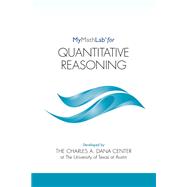NOTE: Before purchasing, check with your instructor to ensure you select the correct ISBN. Several versions of Pearson's MyLab & Mastering products exist for each title, and registrations are not transferable. To register for and use Pearson's MyLab & Mastering products, you may also need a Course ID, which your instructor will provide.
Used books, rentals, and purchases made outside of Pearson
If purchasing or renting from companies other than Pearson, the access codes for Pearson's MyLab & Mastering products may not be included, may be incorrect, or may be previously redeemed. Check with the seller before completing your purchase.
This course is ideal for accelerating students as an alternative to the traditional developmental math sequence and preparing them for a college-level statistics, liberal arts math, or STEM-prep course.
MyMathLab for Quantitative Reasoning is part of a series of MyMathLab courses built to support the New Mathways Project developed by the Charles A. Dana Center. The New Mathways Project embodies the Dana Center’s vision for a systemic approach to improving student success and completion through implementation of processes, strategies, and structures built around three mathematics pathways and a supporting student success course. Quantitative Reasoning develops quantitative literacy skills that will be meaningful in students’ professional, civic, and personal lives. This course emphasizes using data to make good decisions, and its goal is for students to gain the mental habit of seeking patterns and order when confronted with unfamiliar contexts. The MyMathLab course designed for use with Quantitative Reasoning provides:
- Interactive content to help prepare students for active classroom time
- In-Class Interactive Lessons to support students through an active classroom experience, accompanied by notebook PDFs.
- Homework assignments designed to assess conceptual understanding of important skills and concepts.
- Additional resources for instructors to help facilitate an interactive and engaging classroom
Built in MyMathLab
Content developed by the Charles A. Dana Center at The University of Texas at Austin will be delivered through MyMathLab. MyMathLab is an online homework, tutorial, and assessment program that engages students and improves results. Within its structured environment, students practice what they learn, test their understanding, and pursue a personalized study plan that helps them absorb course material and understand difficult concepts.








